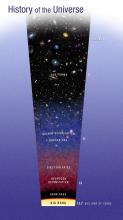Listen to today's episode of StarDate on the web the same day it airs in high-quality streaming audio without any extra ads or announcements. Choose a $8 one-month pass, or listen every day for a year for just $30.
You are here
Stretching Out
Like a housecat after a nap, the universe is stretching its legs. Thanks to the Big Bang in which it was born, the universe is expanding rapidly. Astronomers see that expansion when they look at distant galaxies. Light from these remote objects is stretched to longer wavelengths. How much the light has been stretched reveals a galaxy’s distance.
This effect is known as the cosmological redshift. It stretches lightwaves to longer, redder wavelengths. For the most-distant galaxies, the stretch is huge. Wavelengths that originally were in the ultraviolet — which are much shorter than visible light — have been stretched into the infrared — wavelengths that are longer than visible light.
So the best way to study the very early universe is with infrared telescopes — especially space telescopes, which are above Earth’s infrared-absorbing atmosphere.
The redshifted light of distant galaxies tells us how fast the universe is expanding. The farthest galaxies appear to be moving faster than light. That’s because space itself is expanding faster than light — something that’s allowed by Relativity.
Plotting galaxies at different distances reveals how the rate of expansion has changed. This technique has helped show that the universe is expanding faster today than in the distant past — the result of a mysterious “dark energy.” It may continue to expand faster and faster as it ages — an ever-wider “stretch” that will continue forever.
Script by Damond Benningfield




